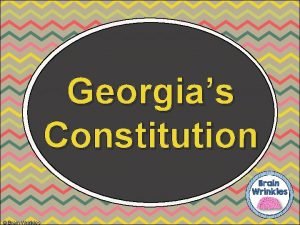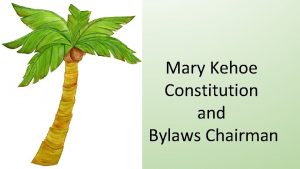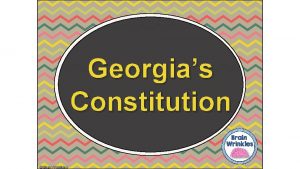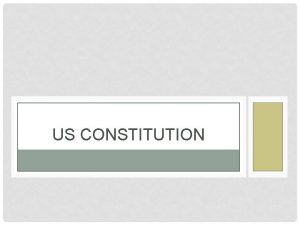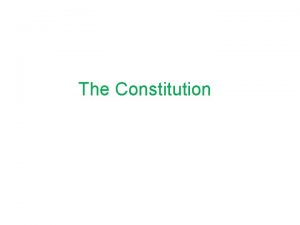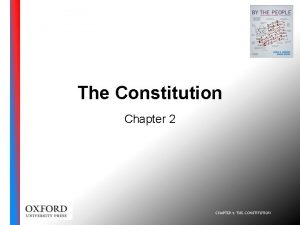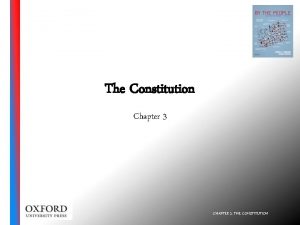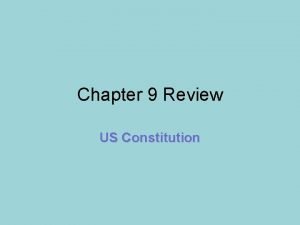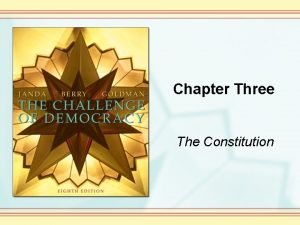The Constitution Chapter 2 CHAPTER 2 THE CONSTITUTION










- Slides: 10

The Constitution Chapter 2 CHAPTER 2: THE CONSTITUTION

In this chapter, you will: • Discover the roots of the Constitution in colonial and revolutionary America. • See why Americans declared independence from England learn about the first constitution, the Articles of Confederation. • Follow the arguments that shaped the Constitution and get an overview of the final document. • Read about the great national debate over whether to adopt it. • Learn how Americans have changed the Constitution—and how the Constitution has changed America. CHAPTER 2: THE CONSTITUTION

The Colonial Roots of the Constitution • Colonists developed their own political institutions, including compacts that became the forerunner of the Constitution. CHAPTER 2: THE CONSTITUTION

Why the Colonists Revolted • For more than a century England ignored its American colonies. Elected assemblies, governed the colonists. After the French and Indian War, the English bypassed the colonial legislatures and imposed new rules and taxes. • These actions violated traditional colonial rights and exposed two different ideas of representation—the American concept of delegate representation (representatives respond to their constituents’ desires) and trustee representation in England (representatives do what they consider best for all). • English action also harmed colonial economic interests. The conflict very quickly escalated. • Americans fought an unusual revolution: Rather than demanding new rights, they were trying to preserve rights and economic interests they had long been exercising. CHAPTER 2: THE CONSTITUTION

The Declaration of Independence • The Declaration of Independence asserted philosophical ideals as the basis of the new American government. • The first part of the Declaration features five ideals that sum up the nation’s political principles. • The second part of the Declaration lists twenty-seven grievances that led to the break. CHAPTER 2: THE CONSTITUTION

The First American Government The Articles of Confederation • Under the Articles of Confederation, thirteen independent states bound themselves into a confederation with a weak central government that had to rely on the states to implement its decisions. • Although feeble, this first U. S. government was, by the standards of the time, a very democratic one. • Delegates to the Constitutional Convention convened to fix the problems with the Articles of Confederation but chose to go much further and propose a new American government. CHAPTER 2: THE CONSTITUTION

Constitutional Convention • • The constitutional framers balanced two dangers: government that was too strong (the king of England) versus government that was too weak (the Articles of Confederation). The debates focused on five central issues: – Should the people be directly involved in government? Most delegates believed in filtration, or indirect elections. – National versus state power, which came down to a standoff between larger and smaller states. Led by Madison, the big states introduced the Virginia Plan. Small states countered with the New Jersey Plan. The Connecticut Compromise offered a solution: House members were elected on the basis of population, but every state had two Senate seats. – The nature of the presidency. – How best to separate powers, answered through a system of checks and balances. For the most part, these limits on concentrated authority would continue to develop long after ratification. – Slavery: Pragmatic compromise overcame moral concerns. Delegates took care not to use the word slavery in the Constitution, but several clauses enabling the institution to grow and expand would lead to the greatest conflict in the nation’s future. CHAPTER 2: THE CONSTITUTION

An Overview of the Constitution • The Constitution is a brief, elegant document with a preamble and seven articles (or major sections). • The Articles of the Constitution address (1) Congress, (2) the President, (3) the Courts, (4) relations between the states, (5) instruction for amending the Constitution, (6) an assertion that the Constitution is the supreme law of the land, and (7) a process for ratifying the Constitution. CHAPTER 2: THE CONSTITUTION

Ratification • The debate over ratifying the Constitution featured two visions of American government. • The Federalists argued that only an energetic national government could protect the nation and secure liberty. The Anti-Federalists called instead for a modest government that left power in state and local hands. • The state-by-state voting on ratification was very close and it was more than a year before the Constitution was approved. • More than 225 years later, Americans are still debating the same question—how strong should the federal government be? CHAPTER 2: THE CONSTITUTION

Changing the Constitution • The Bill of Rights comprises the first ten amendments to the Constitution, which define the rights of American citizens. • Seventeen more amendments (of more than one hundred thousand proposals) followed over the next 215 years. • American politics is always changing, but the Constitution still stands as the American political rulebook. However, the Constitution must be interpreted for it is often unclear what the document means and how it applies to contemporary cases. CHAPTER 2: THE CONSTITUTION











